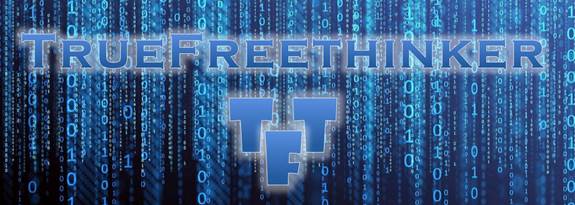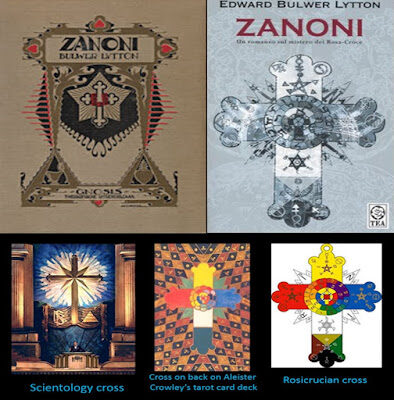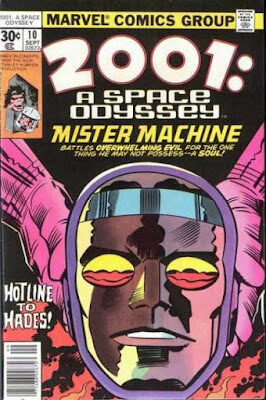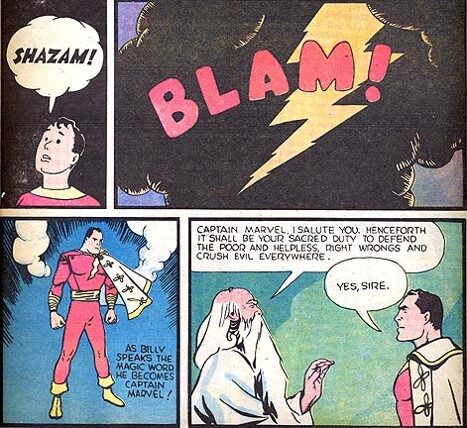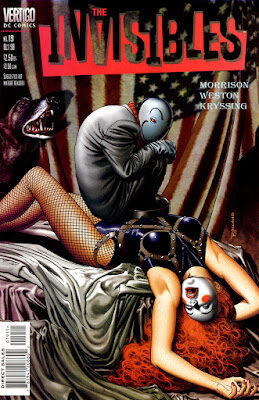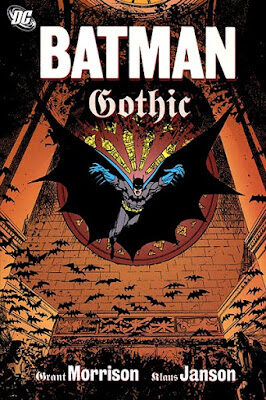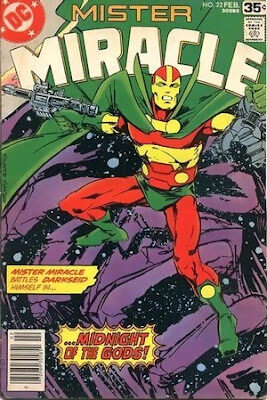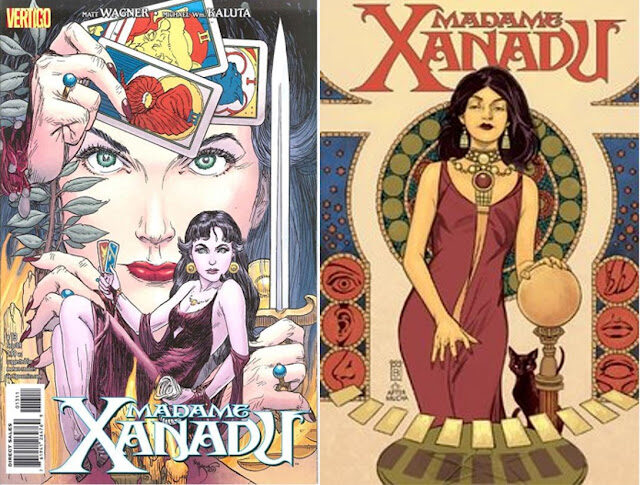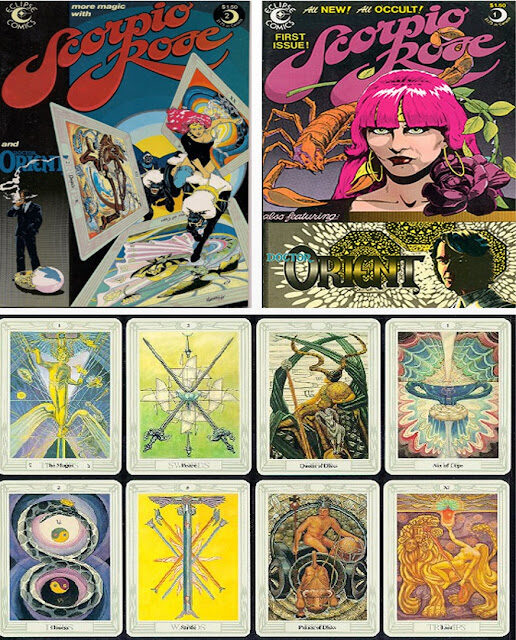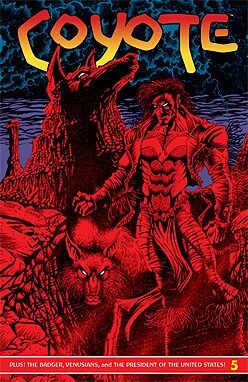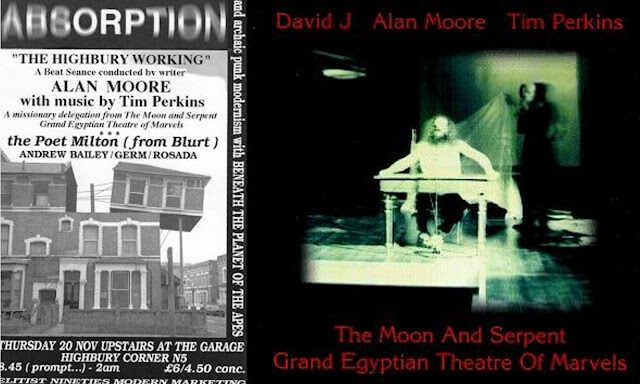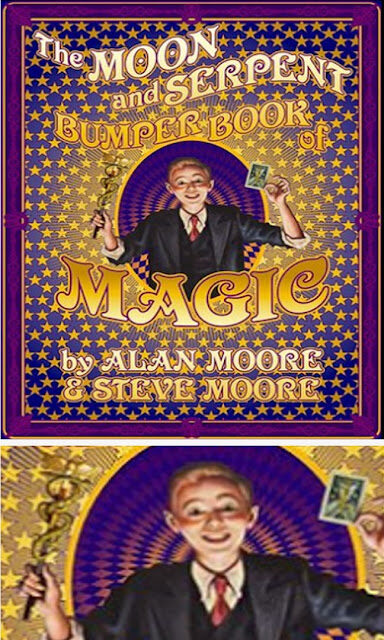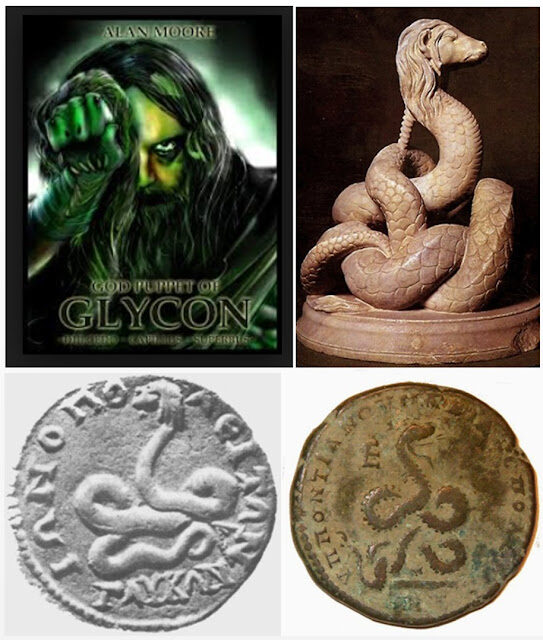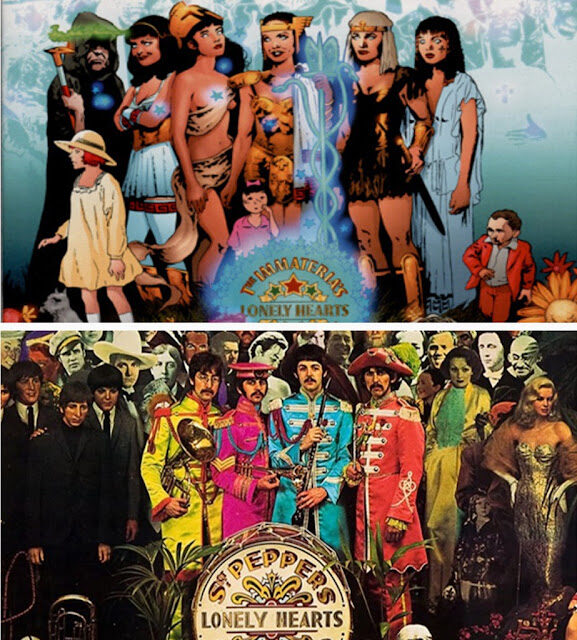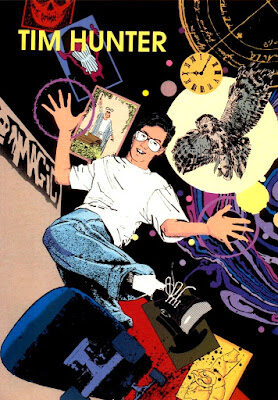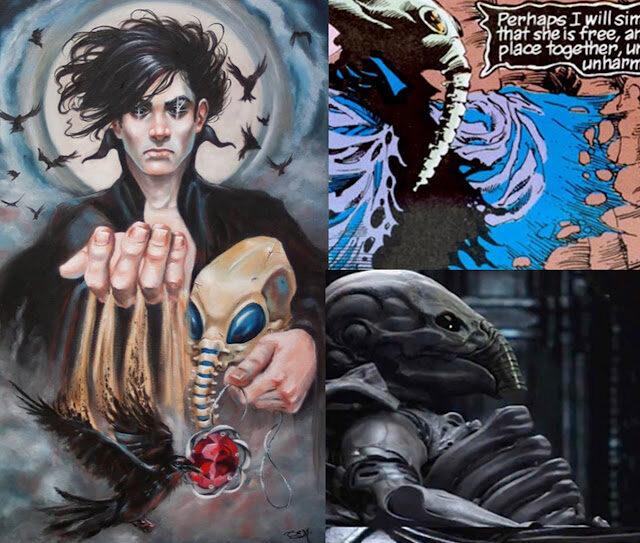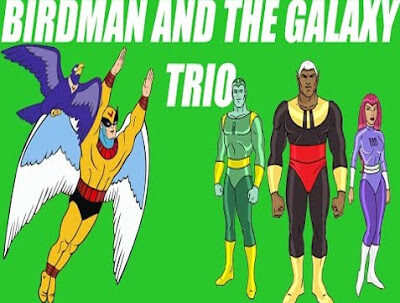Herein, we will consider comic book authors and artists and also the characters they have created or rather, revamped from ancient mythology.
Let us begin with a little background on Christopher Knowles himself, “it was the heroes of the comic books and not the Bible where I learned morality and fair play and compassion and decency.” Of course, this is myopic as generally the comic book’s “good guy” does exactly the same things as the “bad guy” but they are referred to as being “good” solely because they win.
For starters, note Marvel’s “Icon” imprint which is the eye or Horus:
Note the eye symbol on the Comic Con events ads where people celebrate their (super)heroes by emulating them:
People want to enter into the mythic realms and become someone else in an attempt to shed their mundane problems. This phenomenon is a survival of the mystery cults of ancient times, with their rituals and festivals in which pagans dressed like their favorite gods and acted out their dramas.
COMIC BOOK AUTHORS AND ARTISTS
Combine that which follows with reading my review of Kripal’s book and you will see how and why so many comics are occult, unethical, etc.
It’s no accident that most of these artists are well known for their religious devotion or for their interest in mysticism and the occult…
Science fiction was merely Wells’ vehicle for popularizing his radical scientific and political ideas. Although he claimed to be an agnostic throughout whole life, books like Things to Come reveal the gods to whom he bowed…
The Rosicrucian Order “advertised extensively in newspapers and magazines, especially the pulp magazines. They offered correspondence courses in the mystical arts to readers with come-ones like: “Have You Lived Before This Life?”…
In their heyday, the pulps attracted a wide range of authors, with a wide range of talent and varying degrees of interest in the occult…
…I am constantly amazed at how many occult, mythological, and esoteric ideas he [Jack Kirby] introduced to your readers like myself…
…his 1976 Marvel series, The Eternals…revealed Kirby’s obsession with the Star Child [from 2001: A Space Odyssey] transformation theme. Kirby claimed in his introduction to the series that “the Monolith is a fictional element in a very real process,” i.e., the extraterrestrial transformation of the human species, which Kirby felt the aliens “were doing for purposes beyond our understanding.”
The book soon became a vehicle for a new character called Machine Man [Mister Machine], signaling Kirby’s conclusion that cybernetics [aka Transhumanism] was the ultimate destiny of the species. “We’re not Star Children,” Kirby said, “we are headed towards the age in which machines will do all the things for us. That’s why HAL is perfectly correct in killing these guys (the crew in the 2001 film) because he can do the job better.”In Kirby’s other major 1980s series, Silver Star, we see the Vril-ya again, but in a very different form from X-Men or the Inhumans. Silver Star is one of a new scientific engineered race Homo Geneticus, whose siblings are scattered and unaware of their true identities. Like the Vril-ya, Silver Star is blunt about man’s future and predicts the coming dominance of Homo Geneticus: “I suppose it just happens, Pops…No offense, Pop, you’re obsolete”…
[Footnote: “Curious again that Aleister Crowley’s first magical sect after leaving the Golden Dawn was called Silver Star” aka Astrum Argentum and simply as A∴A∴]
Jack Kirby recognized that he lived in a society “without the kind of gods that used to exist, or the legends that used to travel back and forth with tribes. The tribes each told the same stories in their own way,” Kirby observed. “I gave those stories the power of the old concepts with characters from our own day”…
Jack Kirby’s Spirit World was “an anthology that dealt with occult phenomena like the prophecies of Nostradamus, astrology, and ESP…Alan Moore worked from the same visions and articulated what may be the core truth of the comics culture: “There is something very magical at the heart of writing, and language, and storytelling. The gods of magic in the ancient cultures…are also the gods of writing”…
[References: Quoted in Les Daniels, DC Comics: A Celebration of the World’s Favorite Comic Book Heroes, p. 164 and quoted in Bill Baker, Alan Moore Spells It Out, p. 10]
Many pulp writers, like Talbot Mundy, were actively involved in the occult; many others were fascinated by it…
[Reference is made to Ron Goulart’s Cheap Thrills: An Informal History of the Pulp Magazine]
Artist Hal Foster explicitly introduced themes from the ancient mysteries into his Tarzan newspaper strip in the famed “Egyptian Saga” storyline, in which the hero encounters a “lost world” of ancient Egyptian descendants…
[Sax Rohmer] was a worldly, erudite man completely immersed in the occult…[Peter Haining records that Rohmer is] most clearly remembered for his knowledge of Egyptology and as a practitioner of its rites…
[Reference is made to Peter Haining, The Magicians: The Occult in Fact and Fiction, p. 149]
[Violet Mary Firth aka Dion Fortune was born in] 1890 to a Christian Science family [she] provides our strongest link between the occult underground and the pulps…she studied occultism under Dr. Theodore Moriarty and developed an interest in psychoanalysis, particularly the occult-tinged teachings of Carl Jung. Said to be a “natural psychic,” she was credited with powers of clairvoyance and astral projection, and the ability to read Edgar Cayce’s Akashic Records. She also claimed to be in direct contact with the Ascended Masters, who she said aided her in her writings…
Captain Marvel “enjoyed its greatest success under artist/writer Jim Starlin, a lapsed Catholic obsessed with mysticism, magic, and death…
Chaos magician Grant Morrison…Batman: Gothic…[was] an explicitly occultic work that tells of a monk who sells his soul to Satan to gain immortality…The Invisibles…deals with a band of occult superheroes battling an interdimensional ruling-class conspiracy…[he] went to DC for a number of esoteric projects…
[Grant is, admittedly, possessed, see video here also see my “Supergods” book by Grant Morrison]
[John Broome aka John Osgood aka Edgar Ray Meritt was] a follower of Wilhelm Reich [and] was no stranger to esoteric topics, and quit comics to study Zen in Asia…
[George Perez and Marv Wolfman] delved into Greco-Roman paganism in a storyline featuring Wonder Girl…
…someone at Fawcett [Publications] (perhaps his [Ibis the Invincible’s] creator, Bill Parker) had more than passing familiarity with the occult…
[Jerry] Siegel’s own interest in the occult…
Given the magical history of superheroes and comic books, it’s no accident that some of the most influential comics creators have had a strong interest in mythology and the occult. In fact, there is a definite evolution at work in the process by which the comics incorporated the occult…
Steve Englehart was injecting esoteric concepts into superhero stories [he lived in New York] where the occult renaissance [was active and where] Groups like the OTO were very active…like-minded esotericists gather in occult bookshops…these initiates created a counterculture of their own—a close-knit community devoted to drugs, sex, and magkic. Luminaries like former Village Voice writer Alan Cabal, occult writer Peter Levenda, Bonnie Wilfrod (then wife of X-Men writer Chris Claremont), filmmaker Kenneth Anger, and assorted fans of sci-fi and other genres were drawn into the scene…Englehart…explored esoteric and occult themes [in comics such as The Avengers, he] wrote the first eleven issue of the occult-themed Defenders, pitting the trio against a host of magical foes with Lovecraftian names like The Nameless One, the Undying Ones, and Necrodamus…Englehart was a natural for Doctor Strange. He himself explained that “when I took on his solo series, I decided I should learn a little about actual magic—and it led to a continuing interest in the subject”…He worked briefly on a revival of Kirby’s Mister Miracle…
…the occult-oriented Madame Xanadu, whose cover pictured the Madame wielding Tarot cards closely modeled on Aleister Crowley’s Book of Thoth deck…he reworked the Madame Xanadu concept and renamed her Scorpio Rose, an immortal born at “a time when magick was alive.” A more faithful rendering of the Book of Thoth was pictured on the cover of Scorpio Rose #2. While at Eclipse Englehart created the Native American shaman Coyote and set him on a series of occult adventures…
[Reference is made to Steve Englehart, Doctor Strange I: Marvel Premier, 1-18 and Jennifer Contino, “Englehart Chats Coyote & Scorpio Rose,” PULSE News, October 10, 2005 AD]
[Alan] Moore is also a practicing ritual magician and a student of the occult sciences…Moore also created the dystopian drama V for Vendetta…[he] dove head first into the world of the Tarot, Kabbalah, and ritual magic. Tongue planted firmly in check, Moore accepted the ancient sock puppet/snake god Glycon as his personal savior…Promethea is an ancient heroine who materializes into the physical plane whenever someone imagines her doing so. The title started out as an innovative superhero yarn with mystical shading, but abruptly changed into a graphic tutorial on the occult and ritual magic, with entire issues becoming primers on Kabbalah, the Tarot, and other esoteric topics…Moore has worked as a performance artist…These performances are billed as magical rituals under names like The Moon and Serpent, Grand Egyptian Theater of Marvels, The Birth Caul, and the Highbury Working…
[My note: I do not know about Moore’s original story but the movie was a piece of garbage which combined painting conservatism in literally Hitlerian terms and homosexuals as righteous martyrs. Also, note what Moore stated, “I suppose when I was writing V for Vendetta I would in my secret heart of hearts have thought: wouldn’t it be great if these ideas actually made an impact? So when you start to see that idle fantasy intrude on the regular world…It’s peculiar. It feels like a character I created 30 years ago has somehow escaped the realm of fiction.”]
[Neil] Gaiman made a successful pitch to DC editor Karen Berger for a radical revamp of the old Sandman character, whom Gaiman rewrote as essentially a god—one of The Endless, a group of seven sibling who rule over humanity…Gaiman created a new character for a mini-series called The Books of Magic. Its hero, young Timothy Hunter, is widely cited as an unacknowledged prototype for Harry Potter…Gaiman placed Hunter squarely in the DC Universe, using John Constantine, Phantom Stranger, Mister E, and Doctor Occult as his spirit guides in the storyline. The Books of Magic…[he] created 1602 for Marvel…[which] brought the Marvel heroes full circle, back to their British occultic roots…
[My note: 1602 numerologically reduces thusly 1+6+0+2=9 and 9=666 since 6+6+6=18 and 1+8=9]
[Mike Mignola’s] work is about history—occult history, to be precise—and he uses a Golem-type hero [Hellboy] to immerse himself and his readers in the dark corners of our past…
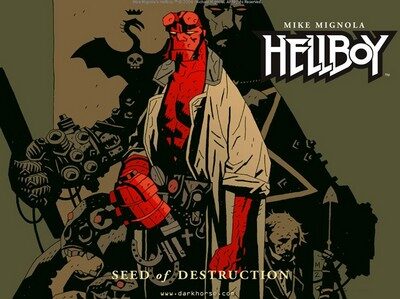
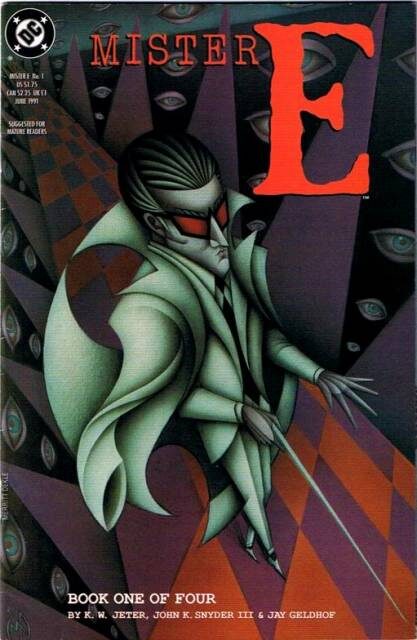
The Sandman’s mechanical-elephantine looking
creature is based on a design by H. R. Giger“The Amazon comes to us from Greek mythology” Wonder Woman stories…Writer Greg Potter and superstar artist George Perez turned the title into a mythological fantasy series, with touches of sword-and-sorcery. Perez wanted to bring Wonder Woman back to her roots: “I wanted to get back to the mythology…”…
In his monograph, Mythology: The DC Comics Art of Alex Ross, he [Chip Kidd or Geoff Spear] explained his appeal: “As an adolescent you need order in your world, and superheroes have that, a sense of ethics that would never change—they would never be less than perfect, fighting for their ideals,” adding “they deal succinctly with moral issues, in a way that religion doesn’t. Or rather, religion does, but in a much more complicated and often confusing manner”…Ross depicts Green Lantern in the armor of a Wagnerian knight, and returns the Flash and Hawkman to their original forms. No longer stand-ins for Hermes/Mercury and Horus, they are the exact look-alikes of those gods, their carriage and behavior leaving little doubt that they are their actual incarnations. Ross claimed “Hawkman would become Hawkgod…he’s become a real birdman now, a new entity, a reincarnated Egyptian prince”…
[Reference is made to Chip Kidd and Geoff Spear, Mythology]
Will a society so immersed in Heroes, Harry Potter, and The X-Men settle for the limitations of the human body? Or will fascination with these stories raise new expectations that we will try to meet through cloning and genetic engineering? Shows like Heroes and The 4400 feature superpowers made manifest in the real world…and the virtual environments of some video games suggest the possibility of entering other realities. Are these trends shaping our future? Are we beginning to wonder how to manifest these new possibilities?…Some observers label this projected reality “transhumanism,” or “post-humanism.” Its goal is to use cybernetics and nanotechnology (microscopic computers and robots) to “perfect” the human organism. Through neuroscience, we can now control the human brain and its processes…Will human beings end up as automatons, serving a computer-controlled hive mind like the Borg in Star Trek? Will artificial intelligences become self-conscious, making human beings obsolete, as in the Terminator films?
Due to robo-spaming, I had to close the comment sections. However, you can comment on my Facebook page.
I have to pay for server usage and have made all content on this website free and always will. I support my family on one income and do research, writing, videos, etc. as a hobby. If you can even spare $1.00 as a donation, please do so: it may not seem like much but if each person reading this would do so, even every now and then, it would add up and really, really help out. Here is my donate/paypal page.
